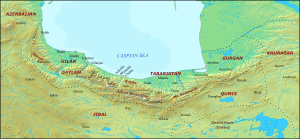Ruyan (district)

Ruyan (
In Iranian mythology, Ruyan appears as one of the places that the legendary archer Arash shot his arrow from, reaching the edge of Khorasan to mark the border between Iran and Turan. The region first appears in historical records as one of the lands of king Gushnasp and his descendants, who served as Sasanian vassals, until they were deposed by the King of Kings (shahanshah) Kavad I (r. 488–496, 498–531).
During the
Baduspanid dynasty, which would rule the area until its conquest by the Safavids
in the 1590s.
History
Ruyan was the name of a mountainous district that encompassed the western part of
Zoroastrian document Yasht and Royishnomand in another Zoroastrian document, the Bundahishn. According to the medieval Iranian scholar al-Biruni (d. after 1050), it was from Ruyan that the legendary archer Arash shot his arrow to the edge of Khorasan to mark the border between Iran and Turan.[2][4]
Ruyan is included among the lands of a local king named Gushnasp according to the
Baduspanid dynasty, which would rule the region until the 1590s.[9] Another son, Dabuya succeeded their father the former as the head of the Dabuyid family, ruling the rest of Tabaristan.[12][9]
The last Dabuyid ruler
Qarinvandids, the Zarmihrids and Baduspanids, formerly subject to the Dabuyids, continued to control the mountainous interior as tributary vassals of the Abbasid government.[14][15][16] These rulers were largely if not completely autonomous.[16]
According to the 10th-century Persian geographers
The Baduspanids were briefly deposed from power by the
Turco-Mongol ruler Timur (r. 1370–1405), who intended to conquer Mazandaran. However, Tus secretly corresponded with Iskandar-i Shaykhi, and eventually joined the forces of Timur in 1392. The following year (1393), Timur dislodged the Mar'ashis and conquered Mazandaran.[18] In 1399/1400, he deprived the Baduspanids of most of their holdings by sending his troops to administer most of Rustamdar. The holdings of the new Baduspanid ruler Kayumarth I were now restricted to that of the castle of Nur.[19][20] However, in 1405, he restored his rule in Rustamdar.[19] He died in 1453. After his death, a dynastic struggle followed, which resulted in his kingdom being split up by his sons Iskandar IV and Ka'us II, in Kojur and Nur respectively.[19] The Baduspanid dynasty was never to be united again, with the two branches ruling separately until they were eventually deposed in 1590s by the Safavid monarch of Iran, Abbas the Great (r. 1588–1629).[20][19]
Notes
- Mazandaran.[1]
References
- ^ Webb 2018.
- ^ a b c d Minorsky 1995, p. 650.
- ^ Bosworth 1968, p. 29.
- ^ Gazerani 2014, pp. 45, 47.
- ^ Blois 2000, p. 188.
- ^ Brunner 1983, p. 765.
- ^ Felix & Madelung 1995, pp. 342–347.
- ^ Pourshariati 2008, p. 288.
- ^ a b c d Ghereghlou 2018.
- ^ Melville 2020, p. 36.
- ^ Madelung 1993, pp. 541–544.
- ^ Yavari 2020.
- ^ Malek 2017, p. 105.
- ^ Madelung 1975, pp. 200–201.
- ^ Rekaya 1986, pp. 68–70.
- ^ a b Malek 2017, p. 106.
- ^ Minorsky 1995, pp. 650–651.
- ^ Bosworth 1984, pp. 742–743.
- ^ a b c d Madelung 1988, pp. 385–391.
- ^ a b Bosworth 1978, p. 808.
Sources
- Bosworth, C. E. (1968). "The Political and Dynastic History of the Iranian World (A.D. 1000–1217)". In ISBN 0-521-06936-X.
- OCLC 758278456.
- Bosworth, C. E. (1984). "Āl-e Afrāsīāb". Encyclopædia Iranica, online edition, Vol. I, Fasc. 7. New York. pp. 742–743.
{{cite encyclopedia}}: CS1 maint: location missing publisher (link) - Blois, F. C. de (2000). "Tansar". In ISBN 978-90-04-11211-7.
- Brunner, Christopher (1983). "Geographical and Administrative divisions: Settlements and Economy". In ISBN 0-521-24693-8.
- Felix, Wolfgang; Madelung, Wilferd (1995). "Deylamites". Encyclopaedia Iranica, Vol. VII, online edition, Fasc. 4. New York. pp. 342–347.
{{cite encyclopedia}}: CS1 maint: location missing publisher (link) - Gazerani, Saghi (2014). "Why Was the Story of Arash-i Kamangir Excluded from the Shahnameh". Iran Nameh: 42–63.
- Ghereghlou, Kioumars (2018). "Bādūsbānids". In Fleet, Kate; ISSN 1873-9830.
- ISBN 0-521-20093-8.
- Madelung, Wilferd (1988). "Baduspanids". Encyclopædia Iranica, online edition, Vol. III, Fasc. 4. New York. pp. 385–391.
{{cite encyclopedia}}: CS1 maint: location missing publisher (link) - Madelung, Wilfred (1993). "Dabuyids". Encyclopædia Iranica, Vol. VI, online edition, Fasc. 5. New York. pp. 541–544.
{{cite encyclopedia}}: CS1 maint: location missing publisher (link) - Malek, Hodge Mehdi (2017). "Tabaristān During the 'Abbāsid Period: The Overlapping Coinage of the Governors and Other Officials (144-178H)". In Faghfoury, Mostafa (ed.). Iranian Numismatic Studies. A Volume in Honor of Stephen Album. Lancaster and London: Classical Numismatic Group. pp. 101–126.
- Melville, Charles (2020). The Timurid Century: The Idea of Iran Vol.9. ISBN 9781838606152.
- ISBN 978-90-04-09834-3.
- Rekaya, M. (1986). "Khurshīd". In ISBN 978-90-04-07819-2.
- Webb, Peter (2018). "Tabarestan". In Nicholson, Oliver (ed.). ISBN 978-0-19-866277-8.
- Yavari, Neguin (2020). "Dābūyids". In Fleet, Kate; ISSN 1873-9830.
Further reading
- Pourshariati, Parvaneh (2008). Decline and Fall of the Sasanian Empire: The Sasanian-Parthian Confederacy and the Arab Conquest of Iran. I.B. Tauris. ISBN 978-1-84511-645-3.
